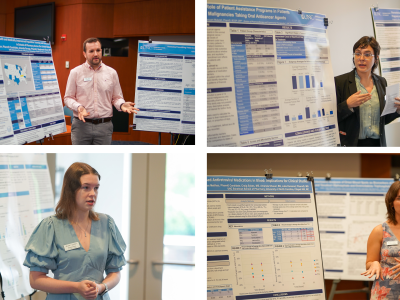February 23, 2014

- UNC and Rensselaer scientists have created a synthetic form of low-molecular-weight heparin that is commonly used in surgeries to prevent blood clots.
- The new heparin is cleared by the liver instead of by the kidneys.
- The anticoagulant effects of this new heparin can be fully reversed with an existing drug should a patient experience bleeding,
- The research team was led by Jian Liu, PhD, and Robert Lindhardt, PhD.
Researchers at the University of North Carolina at Chapel Hill and Rensselaer Polytechnic Institute have created a synthetic form of low-molecular-weight heparin that can be reversed if things go wrong and would be safer for patients with poor kidney function.
“When doctors talk to me about the kind of heparin they want to use during and after surgery, they want it reversible, and they want it to not go through the kidneys,” says Jian Liu, PhD, one of the inventors of the new drug.
While unfractionated heparin is the type commonly used in procedures such as dialysis, the more-refined low-molecular-weight heparins are the drugs of choice for preventing dangerous blood clots in hospitalized patients. A team led by Liu and RPI’s Robert Lindhardt, PhD, created a synthetic version of LMW heparin that can be counteracted by an existing drug. Their creation is described in an article published online February 23 by Nature Chemical Biology.
It’s Reversible
Up to 5 percent of patients receiving heparin experience some form of uncontrolled bleeding. Patients receiving unfractionated heparin are in less danger because there is an existing FDA-approved antidote (protamine) available. Protamine is not as effective in reversing low-molecular-weight heparin so Liu and Lindhardt tweaked their drug’s molecular structure so that protamine is able to deactivate it.
Avoiding the Kidneys
LMW heparin is cleared from the body by the kidneys, which can make it unsuitable for patients with a weakened renal system, a relatively common condition among hospitalized patients.
“If a person’s kidneys aren’t effectively clearing heparin from the blood, the drug stays active in the body for longer than expected,” says Nigel Key, MD, a hematologist with UNC Health Care and the UNC School of Medicine and one of the paper’s coauthors. “That can represent a potentially dangerous situation for the physician, pharmacist, and patient.”
More about Heparin

Heparin is a naturally occurring polysaccharide that prevents blood clotting, or coagulation, and has been in use since the late 1930s. A polysaccharide is a long chain of carbohydrate molecules. There are three main types of heparin: unfractionated, the more highly processed low molecular weight heparin, and the synthetic fondaparinux. Natural heparin is most commonly extracted from the linings of pig intestines.
Heparin prevents blood clots from forming and is most often used during and after such procedures as kidney dialysis, heart bypass surgery, stent implantation, indwelling catheters, and knee and hip replacement. Its side effects can include uncontrolled bleeding and thrombocytopenia (too few platelets in the blood). The worldwide sales of heparin are estimated at $4 billion annually.
The natural form of the drug was in the spotlight in spring 2008 when more than eighty people died and hundreds of others suffered adverse reactions to it, leading to recalls of heparin in countries around the world. Authorities linked the problems to a contaminant in raw natural heparin from China.
“The pig stuff has served us well for fifty years and is very inexpensive, but if we cannot control the supply chain, we cannot ensure the safety of the drug,” Liu says. “I am working for the day when synthetic heparin can be brewed in large laboratories at a low cost.”
The Study Authors
Liu is the John A. and Deborah S. McNeill Jr. Distinguished Professor in the UNC Eshelman School of Pharmacy. Lindhardt is the Ann and John H. Broadbent, Jr. ’59 Senior Constellation Professor of Biocatalysis and Metabolic Engineering in the RPI Department of Chemistry and Chemical Biology.
Liu and Lindhardt’s coauthors are
- Professor Nigel Key, MD; Associate Professor Rafal Pawlinski, PhD; and postdoctoral fellow Erica Sparkenbaugh, PhD; of the UNC School of Medicine;
- Assistant Professor Yongmei Xu, PhD; graduate students Kasemsiri “Joyce” Chandarajoti and Po-Hung Hsieh; and research technician Truong Pham of the UNC Eshelman School of Pharmacy;
- Chao Cai and Lingyun Li, of Rensselaer Polytechnic Institute;
- Associate Professor Juzheng Sheng, PhD, of Shandong University in Jinan, China; and
- Assistant Professor Edward Harris, PhD, of the University of Nebraska.
Latest News

Dean Angela Kashuba receives Carolina Alumni Faculty Service Award

RASP poster presentations capture student research


